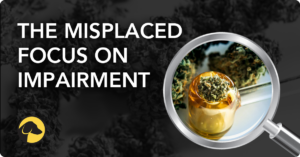
The Difficulty of Defining a Cannabis Impairment Standard
Emerging cannabis laws and legacy drug testing technologies with long cannabis detection windows are presenting new challenges for employers. These often relate to the growing need for an effective solution capable of helping employers deter cannabis use, maintain safe workplaces, and ensure employees are treated fairly.
Recently, I led a roundtable discussion at one of the largest employee screening conferences in the country. We brought three industry experts together to discuss how cannabis legalization is reshaping workplace drug testing from their respective areas of expertise – employer risk and safety, science and technology, and employment law.
A key theme uncovered in this conversation is that the line between workforce cannabis testing and impairment is blurry at best. Now, this may be a new concept for some employers and legislators who’ve been led to believe that the purpose of cannabis testing is to detect impairment. But as you’ll read below, these experts establish that workplace drug testing has never been about proving an impairment standard but rather detecting and deterring drug use in the first place. Here are excerpts from our roundtable discussion.
THE VALUE OF WORKPLACE DRUG TESTING with Robin Schelling, global substance prevention program leader for one of the world’s largest oil and gas operators.
The status of cannabis testing right now is similar to where alcohol testing began. Alcohol was legal, but employers still had a right to ensure employees weren’t coming to work under its influence. Employers were able to deter use with a breath detection solution that provided a quantitative measure to indicate whether an employee had recently used alcohol.
Thus far, drug testing hasn’t been able to offer a comparable solution to alcohol testing – namely, a breath-based test to determine recent use. Historic programs using oral fluid, urine, or hair testing only measured the presence of a substance. Those results merely indicate that a substance is detected in a person’s system, not when it was used. But many employers want to ensure that employees are fit for duty when they show up to work and stay fit for duty throughout the workday. The ultimate value of a workplace drug testing program is to keep employees safe from the impacts of drugs and alcohol in the workplace.
To accomplish this in the era of cannabis legalization, employers need a testing solution capable of detecting recent use.
THE VALUE OF RECENT USE TESTING with Barry Sample, Ph.D., workforce drug testing expert and Senior Science Consultant on Hound Labs’ Scientific Advisory Board.
One of the most common questions I receive is, “If you can test for alcohol to determine if someone’s impaired, why can’t you do that for cannabis – especially now that we have the technology to detect THC in breath?” I wish the answer were simple.
The main point many people fail to realize is that alcohol had decades, literally decades, of study to get to an impairment standard. Researchers examined blood, then breath, and it took an extraordinary amount of time for the scientific and legal communities to reach a consensus on a national standard and per se limits for blood alcohol levels and the relationship between blood and breath. Study data and broad consensus on its outputs are key pieces legislators have been missing as part of determining an impairment standard for cannabis.
Cannabis is more complicated than alcohol due, in large part, to its variable routes of administration. Quite frankly, assessing an impairment standard for cannabis is something that no hair, oral fluid, urine, or breath test can do today. However, the much shorter detection window of THC in a cannabis breath test may provide a narrower inference of when cannabis was used relative to when an employee is being tested. That information could be useful for employers who are focused on the true value of drug testing – deterring cannabis use so workplaces can remain safe.
THE DIFFICULTY OF DEFINING IMPAIRMENT with Faye Caldwell, founding partner at Caldwell Everson, a leading employment law firm based in Houston, Texas.
There is a critical, yet often confused, distinction between a per se limit and what we call impairment in the United States. While impairment is a word tossed around a lot, it is not a defined standard.
For example, a person who doesn’t drink alcohol may have one drink and be impaired, while someone with a drinking tolerance may have five cocktails and be just as impaired as the person who had one drink. Our laws do not distinguish those two people. It is literally a per se limit; it is not a scientific definition of impairment.
Cannabis legalization and its corresponding increase in use have brought into question how employers test for the presence of a substance and attempt to determine impairment. Previously, the presence of an illegal drug – even if the person hadn’t recently used it – was enough to remove a person from a position. Because most employees have increased access to legal cannabis, this approach may no longer be seen as an appropriate inquiry or the basis for a decision on employment status.
Cannabis impairment is a legally complex topic, and I believe we are decades away from establishing a standard definition on a national basis.
A NEW SOLUTION
The question remains – how can employers implement testing to protect both themselves and their employees who use cannabis outside of work? Traditional test types such as oral fluid, urine, and hair have windows of detection that can last days, weeks, or months after use. Employers can’t afford to risk lawsuits, production downtime, and the costs of replacing employees who were terminated because they failed to pass a conventional cannabis drug test.
The answer for companies in the era of cannabis legalization may be a test for recent cannabis use which serves as the best measure to determine if an employee’s use and corresponding test results comply with company workday policies. This approach may better satisfy an employer’s need to deter and detect cannabis use without relying on a premature impairment standard.
HOW TO LEARN MORE
The complete roundtable discussion is available as a webinar on our website. Click here if you’d like to gain access to it.
We also often include webinars like this in our monthly newsletter, along with a selection of recent blogs, published articles, and company announcements. Don’t miss any updates from Hound Labs, subscribe to the Hound Herald.

April 6, 2023
By AARON ATKINSON
EXECUTIVE VICE PRESIDENT OF MARKETING
Share











